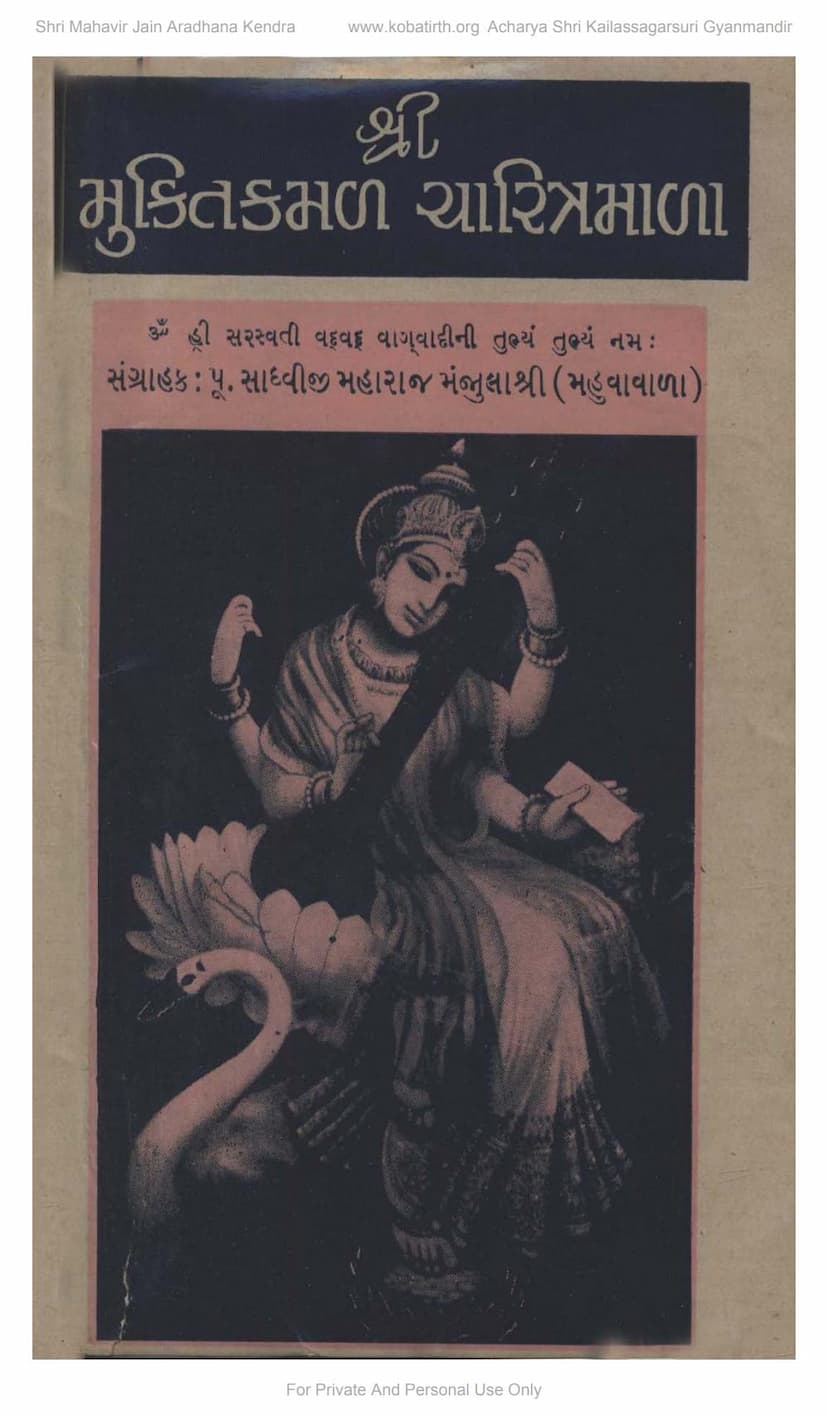Mukti Kamal Charitra Mala
Added to library: September 2, 2025

Summary
Here's a comprehensive summary of the Jain text "Mukti Kamal Charitra Mala" by Manjulashreeji, based on the provided pages:
Overall Title and Theme:
The book is titled "Mukti Kamal Charitra Mala," which translates to "Garland of Liberated Lotus Characters" or "Garland of Characters Leading to Liberation." The overarching theme is the path to spiritual liberation (Mukti) within the Jain tradition, likely presented through the lives, stories, and practices of various individuals or through teachings that guide towards this goal.
Author and Publisher:
- Author/Compiler: Poojya Sadhviji Maharaj Manjulashreeji (Mahuvawala). This indicates that the book is a compilation or collection of Jain spiritual literature, likely curated by a Jain nun.
- Publisher: Jain Shravika Upashray, Bhavnagar. This suggests the publication originated from a Jain laywomen's center or institution in Bhavnagar.
- Second Edition: Published in Vir Samvat 2498 / Vikram Samvat 2028, indicating a significant effort to make this collection available.
Content Overview (as gleaned from the pages provided):
The book appears to be a comprehensive collection of Jain devotional and ritualistic texts, prayers, and explanations. Based on the table of contents and introductory pages, it includes:
-
Prabhuprayer (Lord's Prayers):
- Navasmaranadi Stotra (Recitation of Ninefold Remembrance).
- Devavandan Adi (Worship of Deities, etc.).
- Chaitravandan (Worship of Jain temples/shrines).
- Yagna (Sacrifice/Ritual).
- Dhal Stavana (Verses of Praise).
- Sajzhaya (Devotional Songs/Verses).
- Pachkhan (Vows/Abstinences).
- Chhutak Samjuti (Miscellaneous Explanations).
-
Specific Sections:
- Shuknavali & Atmaraksha: Likely sections on auspicious omens and self-protection through spiritual means.
- Saraswati Stotra: Prayers to Goddess Saraswati, often invoked for knowledge.
- Shatrunjay Lahu Kalpa: A concise ritual or guide related to the holy pilgrimage site of Shatrunjay.
- Devavandan Vibhag: A dedicated section for various types of deity worship.
- Pancha Kalyanak related Dhal: Verses (Dhal) related to the five auspicious events in the life of Tirthankaras.
- Sajhzhaya section: Devotional songs covering various themes and occasions.
- Pachkhan Section: Detailed explanations and rituals for taking vows.
- Katha (Stories): Numerous stories are mentioned, including:
- Dasha Drishtant (Ten examples/parables).
- Diwali ni Katha (Story of Diwali - likely a Jain perspective).
- Helika Ni Katha (Story of Helika).
- Chamoli Katha (Story of Chamoli).
- And many more related to specific festivals and rituals.
-
Invocations and Praises:
- The book begins with invocations to Goddess Saraswati and Lord Mahavir.
- It also includes salutations to Shatrunjay Tirth and "Mukti Kamal Guru."
- There are references to specific deities like Dharanendra and Padmavati, and Lord Parshvanath.
-
Philosophical and Ethical Teachings:
- The text seems to emphasize the importance of knowledge, virtue, detachment, and ethical conduct for achieving liberation.
- There's a strong emphasis on understanding karma and its consequences, with stories illustrating the results of actions (like the story of Kalavati).
- The concept of "Avasharpi Kaal" (the descending era) is mentioned, highlighting the challenges of practicing religion in a time without Tirthankaras.
-
Compilation and Preservation:
- The compiler, Manjulashreeji, expresses a desire to collect and present these teachings to the public for their benefit, especially in an era where moral and spiritual values are declining.
- The text highlights the role of printing in spreading knowledge and making these spiritual texts accessible.
- The effort to compile and republish this "Apurna Sangrah" (unprecedented collection) underscores its value.
-
Support and Acknowledgement:
- Pages 13-19 list numerous individuals and organizations who contributed financially to the publication of the second edition, indicating the book's importance to the Jain community. This is a significant detail showing community support for spiritual literature.
Key Figures and Concepts:
- Lord Mahavir: Revered as the central figure.
- Lord Rishabh (Adinath): Mentioned in prayers and related content.
- Lord Parshvanath: Specifically invoked, along with associated deities Dharanendra and Padmavati.
- Acharya Shri Kailassagarsuri: Associated with the Kendra where the book is cataloged, likely a prominent spiritual figure.
- Acharya Vijaymansurishwar Maharajsahebji & Vruddhichandji Maharaj: Mentioned in relation to Bhavnagar's spiritual heritage.
- Acharya Shri Vijay Kamal Surishwarji: His stanzas are included.
- Mukti Kamalji: The book is dedicated to or named after this figure.
- Navsmaran: A core Jain practice.
- Devavandan, Chaitravandan: Essential devotional rituals.
- Avsarpini Kaal: The current era of decline in spiritual potency.
- Jinagam & Jinbimb: Mentioned as key tools for spiritual guidance in the current era.
- Gorkh Patra: Appears to be a section with astrological or divinatory charts related to omens for travel.
Purpose and Significance:
"Mukti Kamal Charitra Mala" serves as a valuable resource for Jain followers, providing a structured collection of prayers, rituals, stories, and explanations crucial for spiritual practice and understanding. It aims to guide individuals towards knowledge, virtue, and ultimately, liberation, especially in challenging times. The extensive list of donors for the second edition indicates its perceived importance and the community's commitment to preserving and disseminating such spiritual knowledge.